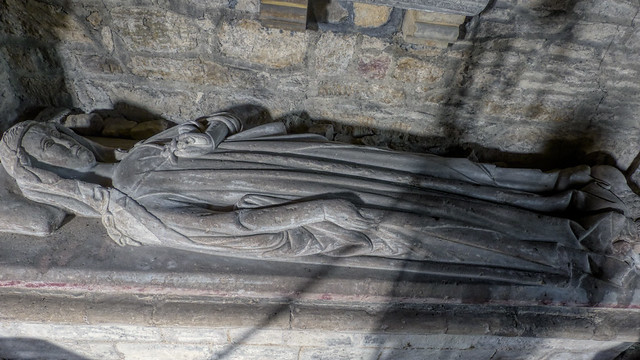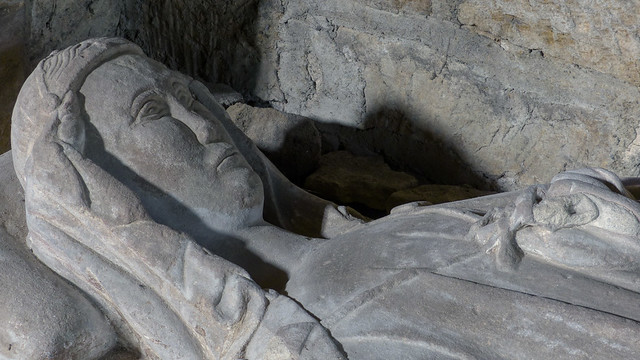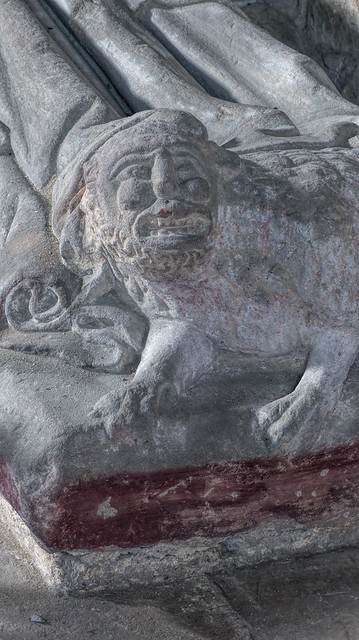Scholastica de Gayton - Gayton Northamptonshire

Scholastica de Gayton, who died in 1354, was a member of the medieval de Gayton family, long associated with the village of Gayton in Northamptonshire. She was the daughter of Sir Philip de Gayton, who died in 1316 and whose own effigy also survives in the church of St Mary the Virgin at Gayton. Scholastica is said to have married a man named Godfrey de Meaux (sometimes recorded as Meux or Meaux), and her life and death are commemorated in one of the church’s most remarkable medieval monuments.
Her tomb lies in a recessed arch along the north wall of the church, within what is often called the north chapel. The effigy shows a recumbent lady resting her head on a square cushion. She wears a long flowing gown and mantle fastened by a cord, and a veil held in place by a fillet encircles her head. The hands are raised in prayer, and the modelling of the drapery is unusually naturalistic for the period, giving the impression of soft folds and a lifelike posture. Scholars of medieval funerary sculpture have described the effigy as one of the most beautiful early fourteenth-century monuments in Northamptonshire, remarkable for its grace and realism.

The head rests gently upon a square cushion, carved with folded edges that suggest the softness of fabric. Scholastica’s face is calm and dignified, the features refined and slightly idealised in the manner typical of mid-14th-century English sculpture. Her eyes are open and gaze slightly upward, giving an impression of serene contemplation rather than sleep. The lips are closed and delicately shaped, conveying a composed, spiritual stillness.
She wears a close-fitting veil drawn around her head and neck, surmounted by a narrow fillet or circlet, an attribute often seen in female effigies of gentle or noble birth. The veil’s edge is crisply defined, framing her face and falling in soft folds across her shoulders. The upper torso is covered by a long robe or gown, over which lies a mantle fastened at the chest by a knotted cord. The drapery is handled with remarkable realism: the folds flow naturally down her sides and across her body, creating depth and movement even in stone.
The effigy of Scholastica de Gayton embodies the refined elegance characteristic of English art around 1330–1350, a period often described as the “court style” of the Decorated Gothic. Her slender proportions, elongated neck, and softly flowing drapery parallel the graceful figures seen in contemporary stained glass123 and manuscript illumination, where linear rhythm and spiritual poise replaced earlier solidity and realism. In both sculpture and glass, the emphasis on verticality and delicate contour was less a study in anatomy than an expression of piety and nobility: the human form idealised as a vessel of grace. A style that would later return centuries later with the Pre-Raphaelites. Scholastica’s effigy thus stands within a coherent aesthetic language that sought to translate earthly dignity into divine refinement.

At her feet lies a sculpted lion, the traditional emblem of courage and fortitude, which was a common feature at the foot of both male and female effigies of this period. The lion is shown crouching, its forepaws extended, and its head turned outward as if on guard. Despite centuries of wear, traces of the original pigmentation survive, reddish tones can still be seen along the base, suggesting that the sculpture was once brightly painted. The lion’s mane and facial features are expressively carved, giving the creature a slightly humanised character typical of medieval symbolism.
The positioning of the feet, resting gently upon the lion’s back, signifies not only nobility and protection but also, in a Christian sense, triumph over sin and the material world.
Above or near Scholastica’s figure is a smaller effigy of a young girl, identified as Mabilla de Murdak. Though easily overlooked beside Scholastica’s grander effigy, this modest monument tells a story just as compelling, of innocence, remembrance, and a family’s attempt to redeem its name in the shadow of tragedy. She is said to have been the daughter of Thomas de Murdak and Juliana de Gayton, another daughter of Sir Philip de Gayton and therefore Scholastica’s niece. The pairing of the adult woman and the child within the same recess suggests that the de Gaytons intended to commemorate several generations of their family together, uniting them in stone within the walls of their parish church.
